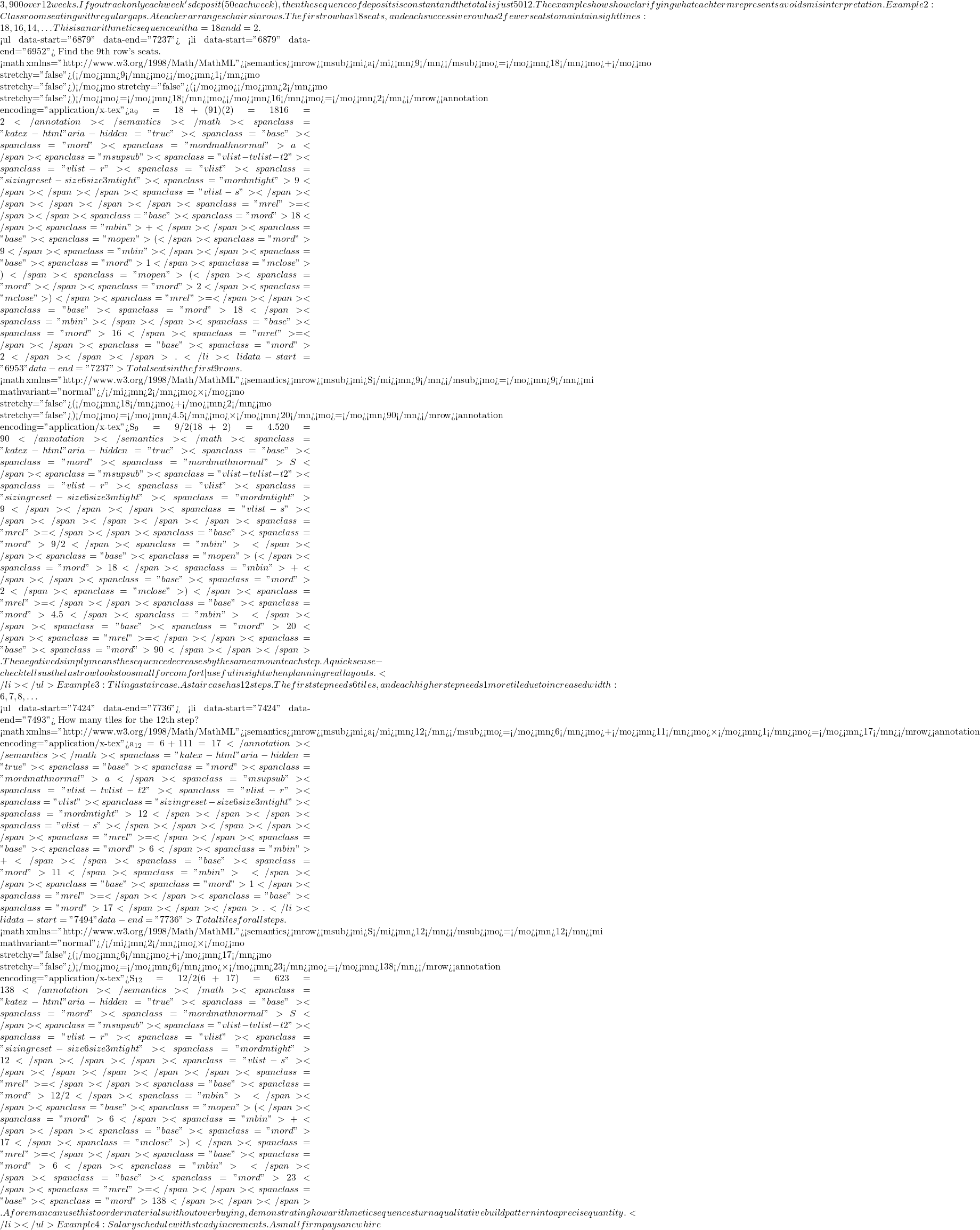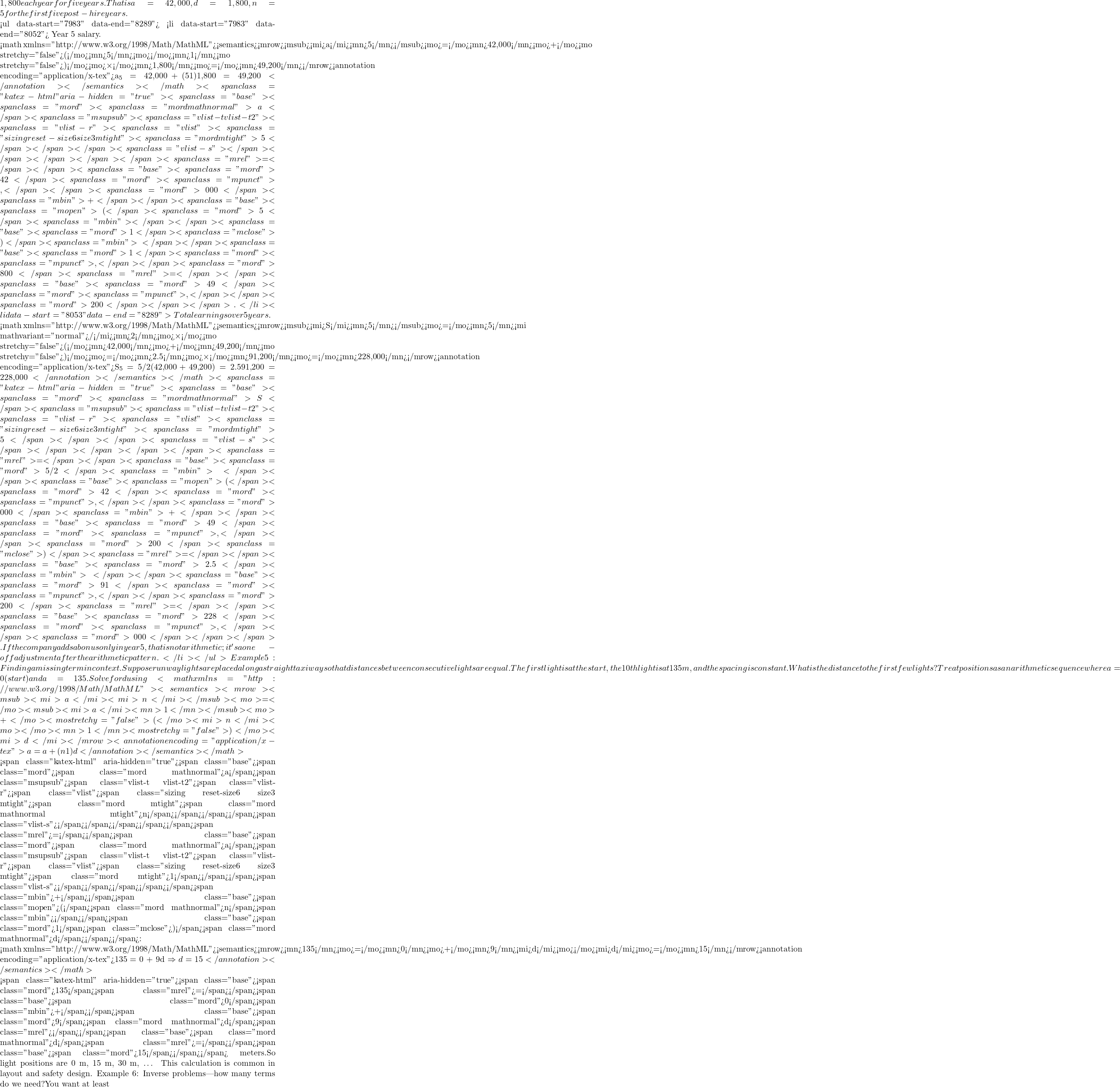An arithmetic sequence is a list of numbers that increases or decreases by a constant amount, called the common difference. The nth term equals first term plus (n−1) times the difference: aₙ = a₁ + (n−1)d. The sum of n terms is Sₙ = n/2 × (first + last).
Table of Contents
-
What Is an Arithmetic Sequence?
-
Core Formulas and How They Connect
-
A Step-by-Step Strategy That Always Works
-
Real-Life Applications and Worked Examples
-
Common Pitfalls, Extensions, and Teaching Tips
1) What Is an Arithmetic Sequence?
An arithmetic sequence is a sequence of numbers where each term is obtained by adding a fixed value to the previous one. That fixed value is the common difference, usually denoted by d. If the first term is a₁, then the second is a₂ = a₁ + d, the third is a₃ = a₁ + 2d, and so on. Because the change between terms is constant, arithmetic sequences model situations with steady, linear growth or decline.
Notation and meaning. We write the sequence as a₁, a₂, a₃, … with n indexing the term number. The subscript tells you the position of a term, not its value. The value of the nth term is aₙ, and it depends on the starting value (a₁) and the step size (d). The index n almost always starts at 1 in textbook problems, unless stated otherwise.
Visual intuition. If you plot the points
on a coordinate plane, you get a straight line. In fact, the arithmetic sequence is the discrete counterpart of the linear function y = mx + b: the slope m corresponds to d, and the intercept b relates to the starting value. This connection makes arithmetic sequences ideal for modeling budgeting with fixed weekly contributions, regular seating patterns, construction layouts with uniform spacing, and other predictable stepwise changes.
Quick checks to confirm it’s arithmetic.
-
The difference between consecutive terms is the same:
for all relevant
.
-
Graph points lie on a straight line when plotted against their term positions.
-
A missing term can be found by consistent addition or subtraction of d.
2) Core Formulas and How They Connect
The formulas below are the backbone of every arithmetic-sequence problem. While they look different, they describe the same structure from different angles.
| Goal | Formula | Use When | Short Example |
|---|---|---|---|
| Nth term (explicit) | aₙ = a₁ + (n−1)d | You know the first term and the common difference, or you can deduce them, and you want a specific term. | If a₁ = 7, d = 3, then a₁₀ = 7 + 9×3 = 34. |
| Nth term (recursive) | a₁ given; aₙ = aₙ₋₁ + d | You prefer building terms step by step (useful for spreadsheets or code). | Start at 7; keep adding 3 to get 10, 13, 16… |
| Sum of n terms | Sₙ = n/2 × (a₁ + aₙ) | You need the total of the first n terms and can find aₙ. | First 10 terms of 7,10,13,… sum to
. |
| Sum without aₙ | Sₙ = n/2 × [2a₁ + (n−1)d] | You don’t know aₙ yet but you know a₁ and d. | With a₁=7, d=3, n=10,
. |
Why these work. The sum formula averages the first and last terms and multiplies by the number of terms. The explicit nth-term formula comes from repeated addition: after
steps of size d starting at a₁, you land at a₁ + (n−1)d.
Choosing the right formula.
-
If the position is the goal (e.g., “Find the 25th term”), think aₙ = a₁ + (n−1)d.
-
If the total is the goal (e.g., “How many tiles in the first 15 rows?”), think Sₙ, using whichever version fits the given information.
-
If terms are defined by process (e.g., “Start at 40, add 12 each month”), a recursive view is convenient for simulation or coding.
3) A Step-by-Step Strategy That Always Works
When faced with an arithmetic-sequence problem, slowing down to identify what you know prevents most errors. Use the following compact routine; it is short enough to apply mentally after a bit of practice.
Step 1—Identify the pattern. Decide whether the situation grows by equal increments. If increases vary or multiply, it may not be arithmetic.
Step 2—Name the parameters. Record a₁ (starting value), d (common difference), and n (term position or count of terms). If one is missing, express it in terms of the others using the explicit formula.
Step 3—Pick the formula.
-
Target a term → aₙ formula.
-
Target a total → Sₙ formula.
-
Need iteration or coding → recursive form.
Step 4—Check units and indexing. Confirm whether the first relevant term is the 1st or the 0th in your context. For totals, verify that n truly counts the number of terms being added.
Mini-case (strategy in action). A mentor program offers stipends that form an arithmetic sequence: ![]() 135,
135, ![]() 15. A student wants to know the 10th stipend and the total of the first 10 stipends. Identify a₁=120, d=15, n=10. Then a₁₀ = 120 + 9×15 = 255. For the total, S₁₀ = 10/2 × (120 + 255) = 5 × 375 = 1,875. The routine cleanly delivers both answers.
15. A student wants to know the 10th stipend and the total of the first 10 stipends. Identify a₁=120, d=15, n=10. Then a₁₀ = 120 + 9×15 = 255. For the total, S₁₀ = 10/2 × (120 + 255) = 5 × 375 = 1,875. The routine cleanly delivers both answers.
4) Real-Life Applications and Worked Examples
Arithmetic sequences show up in planning, construction, schooling, and personal finance whenever changes are uniform. The examples here balance clarity and practicality so you can see the formulas at work without heavy abstraction.
Example 1: Saving with fixed contributions (no interest).
You deposit ![]() 50 in week 1. The deposits form the sequence 50, 100, 150, … where each term represents your cumulative money added (not your bank balance with interest). After n weeks, the weekly addition forms an arithmetic sequence with a₁=50, d=50. If you want the total deposited after 12 weeks, that total is the sum of the sequence’s terms:
50 in week 1. The deposits form the sequence 50, 100, 150, … where each term represents your cumulative money added (not your bank balance with interest). After n weeks, the weekly addition forms an arithmetic sequence with a₁=50, d=50. If you want the total deposited after 12 weeks, that total is the sum of the sequence’s terms:
.
Interpreting it: you have contributed  42,000 in year 1 and increases salary by
42,000 in year 1 and increases salary by  3,000 in a project budget by making regular
3,000 in a project budget by making regular ![]() 3,000? Here a₁=125, d=125, and you need the smallest n such that
3,000? Here a₁=125, d=125, and you need the smallest n such that
That simplifies to
.
Try n = 6:
(too small). n = 7:
(enough).
It will take 7 months of contributions to meet or exceed the goal under a pure arithmetic scheme.
Example 7: Deriving the sum formula quickly.
Write the first n terms forward and backward:
Add vertically to pair terms: each column sums to
, and there are n columns. Hence
so
. This classic trick also explains why the average of first and last term governs the total.
5) Common Pitfalls, Extensions, and Teaching Tips
Mistaking geometric for arithmetic. In a geometric sequence, you multiply by a constant ratio
; in an arithmetic sequence, you add by a constant difference d. If your terms double or halve, that’s not arithmetic. Check one or two gaps to be sure.
Indexing off by one. Many errors stem from plugging n with the wrong starting index. If a schedule labels the first payment as “Month 0,” the explicit formula needs adjusting, or you rewrite the scenario so that the first counted term is a₁.
Sign of the difference. A decreasing pattern means d < 0. The formulas still hold. For totals, decreasing sequences can still have positive sums if the early terms are large enough; just be clear about how many terms are being added.
Forgetting units and interpretation. Be explicit about what each term represents—a deposit, a row’s seat count, a tile count per step, or a position along a line. The same algebra gives different real-world meanings depending on context.
Connecting to linear functions. Writing aₙ = a₁ + (n−1)d as aₙ = dn + (a₁ − d) shows the line form y = mx + b with m = d. This unlocks graphing, quick predictions, and comparison to other linear models. In teaching, switching between the sequence view and the graph view deepens understanding.
Practical extension—spreadsheets. The recursive form
is perfect for a quick spreadsheet: put a₁ in the first cell, then copy a formula that adds d down the column. For totals, use the average-of-first-and-last insight or the closed form Sₙ to verify the spreadsheet sum.
Designing assessments. Mix direct formula questions (find
) with context problems (tiles, seating, budgets). Include at least one inverse problem (find n given a target total) to ensure students can work backward from the sum formula.


